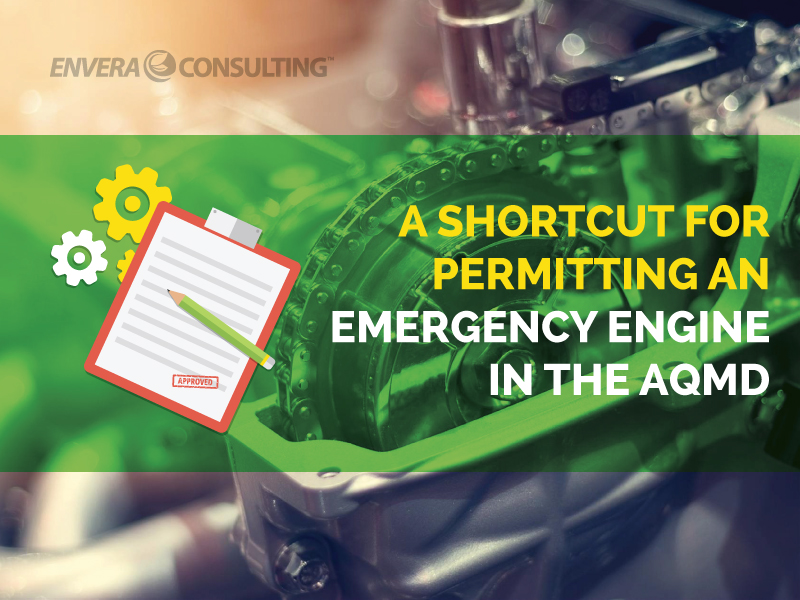
 Emergency engines that drive electrical generators are perhaps the most common type of equipment permitted by the South Coast Air Quality Management District (SCAQMD).
Emergency engines that drive electrical generators are perhaps the most common type of equipment permitted by the South Coast Air Quality Management District (SCAQMD).
In a nutshell, the SCAQMD defines an emergency engine as one that doesn’t operate for more than 200 hours per year and is only operated in the event of a power failure or for routine testing and maintenance — in other words, an emergency backup generator. These engines are commonly found in apartment buildings, office buildings, manufacturing facilities, hospitals, and other premises where having continuous power is considered of utmost importance.
The 4 Ways to Permit an Emergency Engine
When it comes to getting an SCAQMD-compliant emergency engine for your facility, you have four options:
- Rent an engine with a California Air Resources Board (CARB) permit
- Rent an engine with an SCAQMD Various Locations permit
- Go through the regular, full-length permitting process
- Purchase an SCAQMD-certified engine, which requires a much shorter permitting process
Operating an emergency engine in your facility almost always requires getting a permit from the SCAQMD, which can take three to six months — or even longer. The SCAQMD recognizes that the lengthiness of its permitting process can be a project roadblock, so it’s developed a solution: the certified equipment program.
Because emergency engines are considered “standard” pieces of equipment, the SCAQMD uses the certified equipment program (often referred to within the industry as the “certified engine program,” since that’s the equipment type it’s most commonly used for) to streamline the permitting process. That’s done by having both the engine manufacturer and the SCAQMD agree on the permit conditions that will be imposed on the engine, based on its emissions. The manufacturer then applies for an equipment certification from the SCAQMD.
The benefit?
If you qualify for this program, you might be able to get your permit in three to six weeks — not months. The costs are also considerably lower (in the hundreds of dollars, rather than in the thousands). All this magic is possible because the SCAQMD already knows how the specific engine will comply with its rules and regulations.
Do You Qualify for the Certified Equipment Program?
While the certified equipment program may sound like the answer to all your compliance prayers, keep in mind that not every facility is eligible. To make use of the program, the facility must meet the following conditions:
- Not be within 1,000 feet of the outer boundary of a school
- Not be in the Title V program
- Not be within 50 meters of a sensitive receptor*, unless the engine meets the requirements of Rule 1470
- Have an engine that has been certified by the SCAQMD
If you meet the above criteria, congratulations! You’re on your way to a much easier permitting process. All you need to do is submit the following:
- Form 400-A
- Form 400-CEQA
- Form EICE-RE (Emergency Internal Combustion Engine Information for End User)
- SCAQMD engine certification (ask the seller for this at time of purchase)
- Filing fee
While filling out forms is never anyone’s idea of a good time, be thankful you don’t need to go through a complete engineering evaluation, as you would with the regular permitting process. That can be a real bear!
Note that the engine certification you get when you purchase your equipment might look like a permit, but it’s a completely different animal. Just because the equipment is certified doesn’t mean you don’t need a permit — you still have to go through one of the permitting processes.
So before you apply for a permit for your emergency engine, check to see if you’re eligible for the certified equipment program. A little bit of research can save you a lot of time, money, and headache.
Still not sure which permitting process is right for your emergency generator? Contact us. We’re here to help.
* The SCAQMD defines a sensitive receptor as “any residence including private homes, condominiums, apartments, and living quarters, schools as defined under paragraph (b)(57), preschools, daycare centers, and health facilities such as hospitals or retirement and nursing homes. A sensitive receptor includes long-term-care hospitals, hospices, prisons, and dormitories or similar live-in housing.”